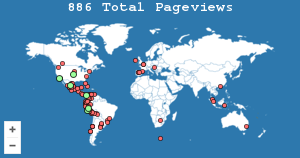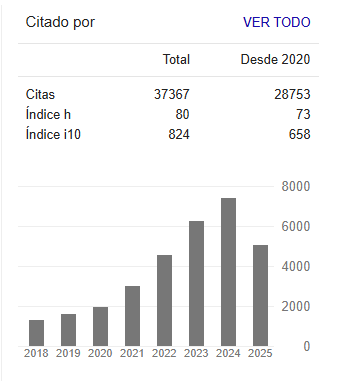Crecimiento de la Micro, Pequeña y Mediana Empresa: un análisis de los factores determinantes
Resumen
El presente trabajo de investigación tiene como objetivo principal identificar los factores que determinan el crecimiento de la Micro, Pequeña y Mediana Empresa establecida en el Estado de Quintana Roo, México. Se utilizó el tipo de investigación correlacional, mediante la aplicación de un análisis factorial y un modelo de regresión múltiple. Para obtener datos se analizan 194 empresas establecidas en las tres zonas económicas del Estado (Norte, Centro y Sur). Los resultados obtenidos indican que los factores que inciden en el crecimiento de este tipo de empresas son: el entorno, las características de la empresa y las características del empresario. Siendo el primero el más significante (estadísticamente). Se concluye que las disposiciones regulatorias y los incentivos económicos implementados por el gobierno mexicano representan el principal determinante en el crecimiento de la Micro, Pequeña y Mediana Empresa establecida en el Estado de Quintana Roo.Citas
Alchian, Armen y Demsetz, Harold (1972), Production, information cost and economic organization, American Economic Review, 62 (5), 777-795.
Aldrich, H. E. y Pfeffer, J, (1976), Environments of organizations, Annual Review of Sociology, 2, 79-105.
Barth, Henrik (1999), Barriers to growth in small firms, Mémoire de licence. Francia: Université de Luleå.
Burns Tom y Stalker George (1961), Themanagement of inovation. Inglaterra:Editorial Lavistock.
Chan, Sui-Yin, y Foster, Margaret (1999), Strategy formulation in small business: the Hong Kong
experience, International Small Business Journal, 19 (3), 56-71.
Chandler, Alfred (1962), Strategy and Structure: Chapters in theHistory of the Industrial Enterprise. Estados Unidos de América: Editorial The MIT Press.
Chrisman, James; Bauerschmidt, Alan y Hofer, Charles (1999), The determinants of new venture performance: an extended model, Entrepreneurship Theory and Practice, 22 (1), 5-30.
Coase, Ronald (1937), Thenature of thefirm, Economica, New Series, 4 (16), 386-405.
Cooper, Arnol, Gimeno-Gascon, Javier, and Woo, Carolyn (1992), Entrepreneurs, process of founding, and new firm performance, in Dean Sexton y Kassandra, Joan, (editores), The State of the Art in Entrepreneurship, Estados Unidos de América: Kent Publishing.
Davidsson, Peer, Achtenhagen, Leona y Naldi, Lucia (2010), Small firm growth, Foundations and Trends in Entrepreneurship, 6 (2), 69-166.
Davidsson, Peer, Kirchhoff, Bruce, Hatemi, Abdulnasser y Gustavsson, Helene (2002), Empirical analysis of business growth factors using swedish data, Journal of Small Business Management, 40 (4), 332-349.
Delmar, Frédéric, Davidsson, Peer y Gartner, William (2003), Arriving at the high-growth firm, Journal
of Business Venturing, 18 (2),
-216.
Delmar, Frédéric, y Wiklund, Johan (2008), The effect of small business managers growth motivation on firm growth: A longitudinal study, Entrepreneur ship Theory and Practice, 32 (3), 437-457.
Dahlqvist, Jonas; Davidsson, Per y Wiklund, Johan (2000), Initial conditions as predictors of new venture performance: a replication and extension of the Cooper et al. Study. Enterprise and Innovation Management Studies, 1 (1), 1-17.
De la Rosa, Ayuzabet (2000), La micro, pequeña y mediana empresa en México: sus saberes, mitos y problemática, Iztapalapa, (20)
,183-220.
Diario Oficial de la Federación (2009), Acuerdo por el que se establece la estratificación de las micro, pequeñas y medianas empresas. Consultado el 6 de enero de 2017 en http://dof.gob.mx/nota_ detalle.php?codigo=5096849&fec ha=30/06/2009
Ericson, Mona (2007), Business Growth: Activities, Themes and Voices. Suecia: Edward Elgar Editores.
Freeman, John y Hannan, Michael (1983), Niche width and the dynamics of organizational populations, American Journal of Sociology, 88, 1116-1145.
Filion, Louis (2004), Operators and visionaries: differences in the
entrepreneurial and managerial systems of two types of entrepreneurs, International Journal of Entrepreneurship and Small Business, 1 (1), 35-
Fotopoulos, Georgios y Louri, Helen (2000). Location and survival of new entry, Small Business Economic,4, (4), 311-321.
Fritsch, Michael; Brixy, Udo y Falck, Oliver (2006), The effect of industry, region, and time on new business survival − a multi- dimensional analysis, Review of Industrial Organization, 28 (3),
-306.
Grant, Robert (1996), Toward a knowledge-based Theory of the Firm, Strategic Management Journal, 17, 109-122.
Guzmán-Díaz, Beatriz, Tarapuez, Edwin, Parra-Hernández Ramiro (2017), Estrategia y calidad en empresas colombianas de servicios, Revista Venezolana de Gerencia, 22 (80), 593-609.
Hannan, Michael y Freeman, John (1977), The population ecology of organizations, American Journal of Sociology, 82 (5), 929-964.
Hannan, Michael y Freeman, John (1988), the ecology of organizational mortality: American Labor Unions, 1836 -1985, American Journal
of Sociology, 95 (1), 25-52.
Instituto Nacional de Estadística y Geografía [INEGI] (2014). Censos Económicos 2014. Consultado el 6 de enero de 2017. http:// www. inegi.gob.mx
Janssen, Francois (2011), La croissace de l’entreprise. Une obligation pour les PME? Bélgica: Editorial de Boeck, Bruxelles.
Jensen, Michael y Meckling, William (1976), Theory of the Firm: Managerial Behavior, Agency Cost and Capital Structure, Journal of Financial Economics, 3 (4) 305-
Julien, Pierre-André, Saint-Jean, Étienne y Audet, Joseé (2006), Les facteurs de discontinuité des PME à fortecroissance, Actes du 8ème Congrès CIFEPME, Fribourg.
Julien, Pierre-André (2005), Entrepreneuriat régional et économie de la connaissance. Cánada: Presses de l’Université du Québec.
Julien, Pierre-André (2002), Les PME à fortecroissance: l’exemple de
gazellesdans 8 régions du Québec. Cánada: Presses de l’Université du Québec.
Lawrence, Paul y Lorsch, Jay (1967),Organization and Environment. Managing Differentiation and Integration. Estados Unidos de América: Editorial Harvard University Press.
Littunen, Hannu; Storhammar, Esa y Nenonen, Tuomo (1988),The survival of firms over the critical first 3 years and the local environment, Entrepreneurship and Regional Development, 10, (3), 189-202.
Lussier, Robert y Pfeifer, Sanjar (2001),
A crossnational prediction model for business success, Journal of Small Business Management, 39 (3), 228-239.
Lussier, Robert (1996), A start-up business success versus failure prediction model for theretail industry, The Mid-Atlantic of Business, 32 (2), 79.
Marchesnay, Michael (1991), La pme: une gestion spécifique, Economie Rurale, 206, 11-17.
Ondel’Ansek, Kay (2014), Les PME a fortécroissance: examen de la documentation de recherche, Série Croissance des PME, Cánada: Editorial HEC Montreal.
Penrose, Edith (1959), The Theory of the Growth of the Firm. Estados Unidos de América: Editorial John Wiley.
Perrault, William, Cannon, Joshep y McCarthy Jerome (2010), Basic Marketing. Estados Unidos de América: Editorial McGraw-Hill.
Rigaud, Benoit, Côté, Louis, Lévesque, Benoit, Facal, Joshep, y Bernier, Luc (2010), Les complémentarités institutionnelles du modèle québécois de développement. Recherches Sociographiques, 51 (1-2), 13-43.
Sánchez-Tovar, Yesenia, Hernández- Hernández Nallely, Zerón-Felix Mariana (2017), Estrategias de negocio en pymes familiares del norte de México: estudio comparativo, Revista Venezolana de Gerencia, 22 (79), 351-367.
Stinchcombe, Arthur (1965), Social structure and organizations,
dans J.G. March (dir.), Handbook of Organizations. Estados Unidos de América: Editorial Rand McNally.
St-Pierre, Joseé y Mathieu, Claude (2003),Innovation in Canadian SMEs: The process, characteristics of firms and their environment, 48th ICSB World Conference, Belfast, Statistique Canada, Enquête sur le financement des petites et moyennesentreprises.
St-Pierre, Joseé, Janssen, Frank, Julien, Pierre,yTherrien,Catherine(2005), Lesfacteurs de croissance des pme manufacturières sur les marchés locauxou internationaux. Belgica: Editorial Institutd’ Administration et de Gestion Université Catholique de Louvain,Belgique.
Storey, David (1994), Understanding the small business sector. Inglaterra: Editorial Routledge.
Van Praag, Mirjam (2003), Business survival and success of young small business owner, Small Business Economics, 21 (1), 1-17.
Woodward, Joan (1965), Industrial Organizations: Theory and Practice. Inglaterra: Editorial Oxford University Press.
Yusuf, Attair (1995), Critical Success Factors for Small Business: Perceptions of South Pacific Entrepreneurs, Journal of Small Business Management, 33,68-73.
Zhou, Haiboy De Wit, Gerrit (2009), Determinants and dimensions of firm growth. Holanda: Editorial Scientific analysis of entrepreneurship and SMEs.








.png)






























